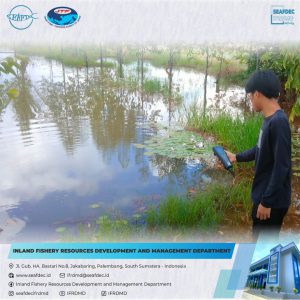𝐖𝐚𝐭𝐞𝐫 𝐪𝐮𝐚𝐥𝐢𝐭𝐲 𝐦𝐨𝐧𝐢𝐭𝐨𝐫𝐢𝐧𝐠 𝐢𝐧 𝐏𝐚𝐭𝐫𝐚 𝐓𝐚𝐧𝐢 𝐈𝐧𝐬𝐭𝐚𝐥𝐥𝐚𝐭𝐢𝐨𝐧
SEAFDEC/IFRDMD visited the pilot project, which collaborated with the Research Institute for Inland Fisheries and Extension (RIIFE), Ministry of Marine Affairs and Fisheries, in Patra Tani Installation, Muara Enim Regency, South Sumatra Province, Indonesia, on 14 May 2024. The Patra Tani installation is one of the floodplain areas where the Musi River floods once a year.
Patra Tani is the lowland that has always been filled with water for a while or permanently. The water sources of the swamp come from the runoff process as rainfall excess, which will be flowing and assembled on the lowland with much substrate decomposition inside; this location is rich with nutrients, which are the source of energy for the live flora and fauna around this ecosystem. Unfortunately, the water has a low pH, and dissolved oxygen is challenging to accept for common species, especially species from the river. Only the blackfish has to have auxiliary respiratory organs that enable them to breathe atmospheric air or behavior that allows them to maintain the eggs and newly hatched fry in relatively well-oxygenated conditions.
Water quality monitoring is a crucial aspect of our project, and it is conducted as a monthly routine observation. The activity is under the project entitled “Management scheme of inland fisheries in the Southeast Asian region” budgeted by Japan Trust Fund VI Phase 2. The data we collect, including dissolved oxygen, pH, water temperature, and water level fluctuation, allows us to observe and identify patterns of change in the water condition. These conditions also provide insights into the readiness of the water bodies in the system for new populations, such as when water is transferred from the river. This process can also serve as a means to transport fish populations to shelter and protection areas, further emphasizing our commitment to environmental sustainability.

